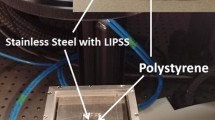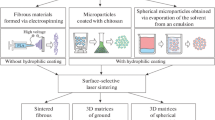Abstract
The performance of a polymeric biomaterial depends on the bulk and surface properties. Often, however, the suitability of the surface properties is compromised in favour of the bulk properties. Altering the surface properties of these materials will have a profound effect on how cells and proteins interact with them. Here, we have used an excimer laser to modify the surface wettability of nylon 12. The surface treatment is rapid, cost-effective and can cause reproducible changes in the surface structure of the polymers. Polymers were treated with short wavelength (<200 nm) UV light. These wavelengths have sufficient photon energy (6.4 eV) to cause bond scission at the material surface. This results in a surface reorganisation with incorporation of oxygen. Surface wettability changes were confirmed using contact angle measurements. Cell interactions with the surfaces were examined using 3T3 fibroblast and HUVEC cells. Cells morphology was examined using a confocal laser scanning microscope (CLSM). Cell activity and cell number on the treated nylon were assessed using biochemical assays for up to seven days. Both fibroblasts and endothelial cells initially proliferated better on treated compared with untreated samples. However, over seven days activity decreased for both cell types on the control samples and endothelial cell activity and cell number also decreased on the treated polymer.
Similar content being viewed by others
References
M. Ozdemir and H. Sadikoglu, Trends in Food Sci. & Tech. 9 (1998) 159.
T. Chandy, G. S. Gladwin, R. F. Wilson and G. H. R. Rao, Biomaterials 21 (2000) 699.
M. Dadsetan, H. Mirzadeh, N. Sharifi-Sanjani and P. Salehian, J. Biomed. Mater. Res. 54 (2001) 540.
J. A. Hunt, R. L. Williams, S. M. Tavakoli and S. T. Riches, J. Mat. Sci. Mater. Med. 6 (1995) 813.
P. K. Chu, J. Y. Chen, L. P. Wang and N. Huang, Mats. Sci. Eng. R 36 (2002) 143.
F. R. Pu, R. L. Williams, T. K. Markkula and J. A. Hunt, Biomaterials 23 (2002) 4705.
S. Dadbin, Europ. Polymer. J. 38 (2002) 2489.
S. M. Short, G. A. Talbott and R. L. Juliano, Mol. Biol. Cell. 9 (1998) 1969.
M. A. Shwartz and M. H. Ginsberg, Nature Cell Biol. 4 (2002) E65.
E. F. Plow, T. A. Haas, L. Zhang, J. Loftus and J. W. Smith, J. Biol. Chem. 275 (2000) 21785.
Author information
Authors and Affiliations
Corresponding author
Rights and permissions
About this article
Cite this article
Ball, M.D., Sherlock, R. & Glynn, T. Cell interactions with laser-modified polymer surfaces. Journal of Materials Science: Materials in Medicine 15, 447–449 (2004). https://doi.org/10.1023/B:JMSM.0000021118.85955.4a
Issue Date:
DOI: https://doi.org/10.1023/B:JMSM.0000021118.85955.4a




